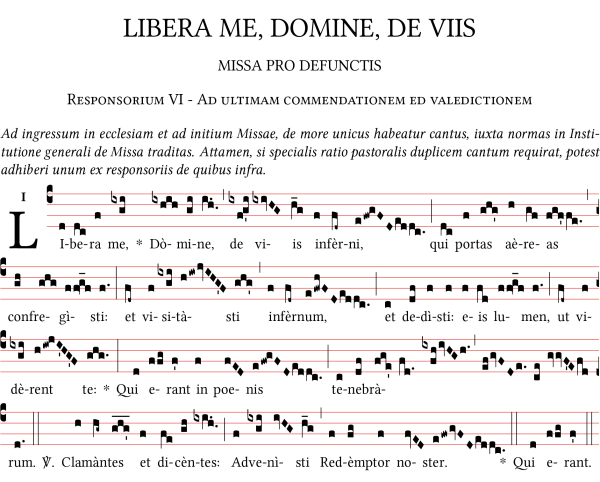Libera me, Domine, de viis (Responsorium)
Questo responsorio intitolato Libera me, Domine, de viis fa parte della Missa Pro Defunctis. In particolare, è il sesto responsorio della liturgia esequiale AD ULTIMAM COMMENDATIONEM ED VALEDICTIONEM ("ultima raccomandazione e addio"), mentre il feretro viene asperso con acqua benedetta ed incensato. Dopo i responsori seguono le Antifone In paradisum, Chorus angelorum e Ego sum resurrectio.
Indice
Testo e traduzioni[1]
Libera me Dómine de víis inférni, Qui érant in pœnis tenebrárum. Clamántes et dicéntes: Qui érant in pœnis tenebrárum. |
Liberami, o Signore, dalle vie degli inferi, Essi abitavano nelle tenebre. Nell'angoscia gridarono: Essi abitavano nelle tenebre. |
Deliver me, O Lord, from the paths of hell, Them that were in the pains of darkness. Them that were crying aloud and saying: Them that were in the pains of darkness. |
Spartiti musicali
Spartito gregoriano, impaginato su foglio formato A4:
Spartito disponibile in formato PDF impaginato su foglio A4, Media:Libera-me-Domine-de-viis-responsorium.pdf
Video
Versione cantata dal Canale YouTube Schola Cantorum Karolus Magnus (tema). Il brano cantato differisce leggermente.
Codice sorgente GABC
name:Libera me, Domine, de viis; office-part:Responsorium; mode:1; book:Graduale Triplex, 1979, p. 696; transcriber:Stefano Ferri; %% (c4) LI-(d)be-(dc)ra(f) me,(ixgi) *() Dò-(ixhih)mi-(gi)ne,(i.h.) (,) de(ixf!g'i) vi-(ixivHG) is(h_g) in(f)fèr-(fd~)ni,(efw!gFDeddc.) (;) qui(dc) por(f)tas(ghg') aè-(h)re-(gf)as(fgf'fe.) (,) con(gh)fre-(ghg)gì-(ff!g_f)sti:(f.) (:) et(fd~) vi-(f)si-(ixgi)tà-(hiwjvIHG'F)sti(ghg') (,) in(f)fèr(fd~)num,(efwhFDeddc.) (;) et(c) de-(df)dì(f)sti:(f) e-(f)is(fd) lu-(ff!g_f)men,(f.) (;) ut(fd~) vi-(f) dè-(ixgi)rent(hiw!jI'HG'F) te:(ghg.) *(:) Qui(d) e-(ffg)rant(f') in(f) poe-(fED)nis(efw!gFDeddc.) (;) te(c)ne(df)brà-(fge' fd. ixfhivHGh.) (,) (efgvFDe. ce gvgvF'Efd) rum.(d.) (::) <sp>V/</sp>.() Cla(h)màn(hg~)tes(ghg___') et(f) di-(fe)cèn-(gh)tes:(ixi.h.) (;) Ad(f)ve-(ixgi)nì-(ivHG)sti(h_g) (,) Red-(f)èmp(fg)tor(f) no-(fvED)ster.(efwgvFDeddc.) *(::) Qui(d) e-(ffg)rant.(f') (::)
Bibliografia
- Neumz.com, link: https://app.neumz.com/listen/matutinum-libera-me-domine-de-viis-inferni-1-more-romano-25124/02-11-2019
- GregoBase project, https://gregobase.selapa.net/
- Graduale Triplex, Libreria Editrice Vaticana 1979, pagina 696.
Note
- ↑ Tratto da Neumz.com, link: https://app.neumz.com/listen/matutinum-libera-me-domine-de-viis-inferni-1-more-romano-25124/02-11-2019
